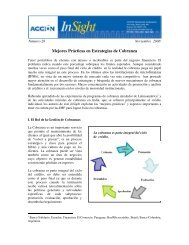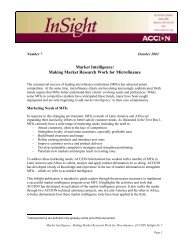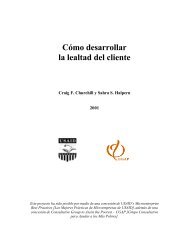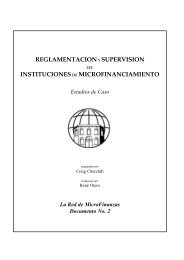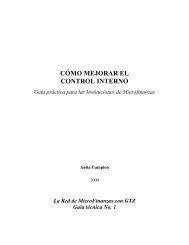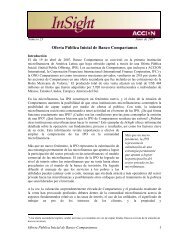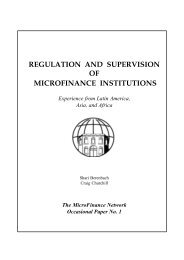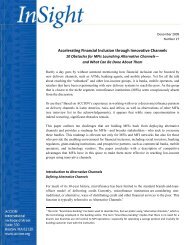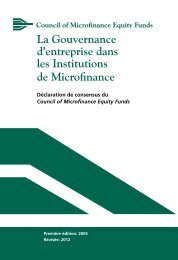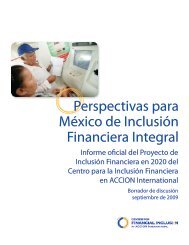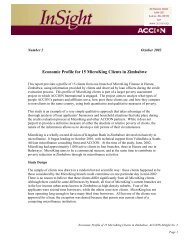the Universal Standards for Social Performance Management
the Universal Standards for Social Performance Management
the Universal Standards for Social Performance Management
Create successful ePaper yourself
Turn your PDF publications into a flip-book with our unique Google optimized e-Paper software.
Insights from “Beta Testing”<strong>the</strong> <strong>Universal</strong> <strong>Standards</strong> <strong>for</strong> <strong>Social</strong> Per<strong>for</strong>mance<strong>Management</strong>Working PaperAs of May 22, 20131
Executive SummaryIn June 2012, <strong>the</strong> <strong>Social</strong> Per<strong>for</strong>mance Task Force (SPTF) launched <strong>the</strong> “<strong>Universal</strong> <strong>Standards</strong> <strong>for</strong> <strong>Social</strong> Per<strong>for</strong>mance<strong>Management</strong>” (USSPM), consisting of 99 Essential Practices (EPs) in six areas. These <strong>Universal</strong> <strong>Standards</strong> areconsidered applicable to any MFI pursuing a double bottom line.Over <strong>the</strong> past year, <strong>the</strong> Microfinance CEO Working Group worked with 21 MFIs to “beta test” <strong>the</strong> <strong>Universal</strong><strong>Standards</strong>. The term “beta test” refers to an analysis of an MFI’s practices related to all of <strong>the</strong> EPs, intending tounderstand <strong>the</strong> process of an assessment and <strong>the</strong> status of an MFI’s current social per<strong>for</strong>mance management, andalso elicit any concerns or issues with <strong>the</strong> <strong>Universal</strong> <strong>Standards</strong> as <strong>the</strong>y now stand. Beta tests were conducted witha variety of partner and affiliate MFIs of <strong>the</strong> Microfinance CEO Working Group, reflecting a wide range ofinstitution sizes and geographic locations.Feedback on Process Members utilized a variety of methodologies, but learned that a full assessment is an in-depthundertaking that requires significant planning and multiple parties. All assessment methods have relative strengths and weaknesses, but ultimately <strong>the</strong> correct approachdepends on <strong>the</strong> institution’s intent (e.g., increasing awareness about social per<strong>for</strong>mance managementbest practices versus preparing <strong>for</strong> a social audit or rating). While <strong>the</strong> assessments were time consuming, participating MFIs found <strong>the</strong>m to be valuable, oftenreporting that <strong>the</strong> assessment provided education on social per<strong>for</strong>mance management best practices.Many institutions also created action plans <strong>for</strong> improving <strong>the</strong>ir practices over time.Feedback on Compliance with <strong>the</strong> USSPM Results indicate that, on average, MFIs believe that <strong>the</strong>y are already compliant with 78% of <strong>the</strong> 99Essential Practices, indicating a high degree of confidence in <strong>the</strong>ir current practices. MFIs reported highest compliance on Section 4 (Design Products, Services, Delivery Models and Channelsthat Meet Clients’ Needs and Preferences) and Section 5 (Treat Employees Responsibly). Challenges vary by institution and country context, but on average MFIs struggled most with Section 1(Define and Monitor <strong>Social</strong> Goals), and had <strong>the</strong> most concerns with Section 6 (Balance Financial and <strong>Social</strong>Per<strong>for</strong>mance).Feedback on <strong>the</strong> <strong>Universal</strong> <strong>Standards</strong> and Recommended Adjustments Our results suggest that <strong>the</strong> USSPM are, on <strong>the</strong> whole, practical and achievable <strong>for</strong> MFIs. MFIs also found<strong>the</strong> USSPM to be largely relevant to <strong>the</strong>ir organizations. However, we believe <strong>the</strong>re are some important issues that should be addressed. These issues areapplicable across <strong>the</strong> USSPM, but most especially in Section 6:o Simplify EPs that contain multiple concepts, and remove duplication of concepts between EPs.o Use clear and simple language, add explanatory examples, and develop a guide that can support MFIsin <strong>the</strong>ir assessments.o Ensure <strong>the</strong> measurability of EPs.Note that our work began be<strong>for</strong>e <strong>the</strong> launch of <strong>the</strong> SPTF’s Indicators Working Group, which aims to developindicators <strong>for</strong> each of <strong>the</strong> 99 Essential Practices. In most cases, participants believe that <strong>the</strong> release of indicatorswill help address <strong>the</strong> above issues, though some have concerns <strong>the</strong>y could add additional confusion. Exceptionalcare should be taken to make <strong>the</strong> USSPM clear and accessible to institutions of all kinds. This will be vital to make<strong>the</strong> USSPM approachable <strong>for</strong> <strong>the</strong> majority of MFIs, not just those that are already steeped in social per<strong>for</strong>mancemanagement.3
While we vary in our level of suggested adjustments, we believe <strong>the</strong> USSPM are an important step <strong>for</strong>ward <strong>for</strong> <strong>the</strong>industry. Moving <strong>for</strong>ward, we would encourage <strong>the</strong> SPTF to fur<strong>the</strong>r communicate <strong>the</strong>ir ultimate goals <strong>for</strong> <strong>the</strong>USSPM to MFIs and <strong>the</strong> broader microfinance community. A clear vision of what <strong>the</strong> SPTF wants to accomplish iscrucial <strong>for</strong> understanding how MFIs – and <strong>the</strong> organizations that support <strong>the</strong>m – should approach <strong>the</strong> <strong>Standards</strong>,and how we can help <strong>the</strong> SPTF be most effective.1. Background and Beta Test GoalsIn June 2012, after several years of development, <strong>the</strong> <strong>Social</strong> Per<strong>for</strong>mance Task Force launched its comprehensive“<strong>Universal</strong> <strong>Standards</strong> <strong>for</strong> <strong>Social</strong> Per<strong>for</strong>mance <strong>Management</strong>.” These <strong>Universal</strong> <strong>Standards</strong>, consisting of 99 EssentialPractices in six areas, are applicable to any MFI pursuing a double bottom line, and fulfillment is considerednecessary <strong>for</strong> an institution to have strong social per<strong>for</strong>mance management practices. The <strong>Standards</strong> weredeveloped through broad industry consultation and draw on <strong>the</strong> best practices and knowledge available.However, at <strong>the</strong> time of <strong>the</strong>ir launch, <strong>the</strong> complete set of <strong>Standards</strong> had not yet been analyzed in a large numberof MFIs. Thus, <strong>the</strong> SPTF asked <strong>for</strong> assistance in “beta testing” <strong>the</strong> full set of <strong>Universal</strong> <strong>Standards</strong>, and <strong>the</strong> membersof <strong>the</strong> Microfinance CEO Working Group, collectively with <strong>the</strong>ir lead social per<strong>for</strong>mance staff members,committed to this ef<strong>for</strong>t.In using <strong>the</strong> term “beta test,” we refer to an analysis of an MFI’s practices against all of <strong>the</strong> Essential Practices of<strong>the</strong> <strong>Universal</strong> <strong>Standards</strong>. This ef<strong>for</strong>t intends to understand <strong>the</strong> process of an assessment and <strong>the</strong> status of an MFI’scurrent social per<strong>for</strong>mance management practices, and also elicit any concerns or questions about <strong>the</strong> USSPM.This ef<strong>for</strong>t hopes to provide insight into several practical questions:Process of Assessment What does it take to conduct an assessment? Are certain methods of assessment more effective than o<strong>the</strong>rs? How do we use <strong>the</strong> in<strong>for</strong>mation that an assessment reveals to improve practices?<strong>Social</strong> Per<strong>for</strong>mance Compliance How do MFIs view <strong>the</strong>mselves vis-à-vis <strong>the</strong> <strong>Standards</strong>? Are some <strong>Standards</strong> harder to comply with? Easier?Perspectives on <strong>the</strong> <strong>Universal</strong> <strong>Standards</strong> and Any Recommended Adjustments Are <strong>the</strong> <strong>Universal</strong> <strong>Standards</strong> relevant, achievable, measurable, and understandable? Are any language adjustments warranted?We hope that our ef<strong>for</strong>ts will help in<strong>for</strong>m any future revisions to <strong>the</strong> <strong>Universal</strong> <strong>Standards</strong>, identify EssentialPractices or <strong>Standards</strong> <strong>for</strong> which MFIs may appreciate additional education or training, and shed some light ontowhat it would take <strong>for</strong> an institution to understand its practices – and <strong>the</strong>n go about making <strong>the</strong>m better. Notethat after our ef<strong>for</strong>ts began, <strong>the</strong> SPTF launched an Indicators Working Group intended to develop preciseindicators <strong>for</strong> each of <strong>the</strong> 99 Essential Practices. We recognize that <strong>the</strong> addition of such indicators may impact <strong>the</strong>process of assessment <strong>for</strong> future MFIs and may address some of our current concerns with <strong>the</strong> <strong>Universal</strong><strong>Standards</strong>; however, we encourage <strong>the</strong> SPTF to view refining <strong>the</strong> USSPM as an iterative process that willnecessarily take some time.The ef<strong>for</strong>t was coordinated by <strong>the</strong> lead social per<strong>for</strong>mance directors of <strong>the</strong> Microfinance CEO Working Group, acollaborative ef<strong>for</strong>t by eight leading microfinance organizations: Accion, FINCA International, Freedom from4
Hunger, Grameen Foundation USA, Opportunity International, Pro Mujer, VisionFund International and Women’sWorld Banking. Please find <strong>the</strong> participating representatives from <strong>the</strong>se organizations in Exhibit 1.2. Participant MFI OverviewA total of 21 beta tests were conducted with partners or affiliate MFIs of <strong>the</strong> Microfinance CEO Working Grouporganizations. A full list of participating organizations can be found in Exhibit 2. Beta tests were conducted inEastern Europe & Central Asia, Latin America & <strong>the</strong> Caribbean, South Asia, Sou<strong>the</strong>ast Asia, and sub-Saharan Africa,providing a global perspective. In addition, Opportunity International also distributed self-assessments to ninepartners in Africa and Eastern Europe.Figure 1: Beta Test MFIs by Region 1Tests included a variety of sizes of MFIs, both extremely small and very large. The smallest MFI countsapproximately 4,000 clients, while <strong>the</strong> largest serves just under 1 million clients. The average number of clients ofparticipating MFIs is 192,000, with <strong>the</strong> median 87,000.Figure 2: Beta Test MFIs by Number of Clients 21 Chart does not include <strong>the</strong> self-assessments that Opportunity received from seven sub-Saharan African MFIs and twoEastern European MFIs.2 Excludes Opportunity’s self-assessments.5
While <strong>the</strong> participating MFIs ranged in <strong>the</strong>ir familiarity and level of prior engagement with social per<strong>for</strong>mancemanagement, <strong>the</strong> majority of <strong>the</strong>se institutions have demonstrated a higher-than-average interest andengagement with social per<strong>for</strong>mance (e.g., many are members of <strong>the</strong> SPTF, have received a social rating or socialaudit, or have participated in pilots or assessments by <strong>the</strong> Smart Campaign or <strong>the</strong> Seal of Excellence). Thus, <strong>the</strong>irexperience may not be representative of <strong>the</strong> “average” MFI.3. Process of AssessmentMethodologies usedGiven <strong>the</strong> differing nature of relationships between each Working Group member and MFI partner and <strong>the</strong>variations in available resources and interests, multiple approaches were utilized. Microfinance CEO WorkingGroup members also reported on <strong>the</strong> success of <strong>the</strong>ir methodologies on a rolling basis, with o<strong>the</strong>r members <strong>the</strong>nadjusting <strong>the</strong>ir approaches accordingly. Methodologies included:Self-assessment: Often, multiple staff members (or a social per<strong>for</strong>mance manager or champion)individually filled out an Excel spreadsheet about an institution’s current status and any issues orconcerns. In several cases, <strong>the</strong> results and areas of difference/alignment were <strong>the</strong>n reviewed in afacilitated session, as outlined below.Facilitated Sessions: Most members incorporated some <strong>for</strong>m of facilitated session, which ranged fromsmall group meetings on specific sections of <strong>the</strong> <strong>Standards</strong> to daylong assessments of <strong>the</strong> entire USSPMwith more than a dozen staff members. Sessions typically incorporated staff from multiple departmentsand different levels of <strong>the</strong> institution and were led by a representative from <strong>the</strong> Microfinance CEOWorking Group organization with extensive experience in social per<strong>for</strong>mance management.Quasi-Audit: In a few instances, an institution contracted with an outside consultant who, in addition to<strong>the</strong> above, per<strong>for</strong>med one-on-one interviews, conducted client focus groups, and analyzeddocumentation.See a more in-depth discussion of a sample of methodologies in Exhibit 3.What methods of assessment are <strong>the</strong> most effective?The appropriate methodology will vary by organization and depends on intent: whe<strong>the</strong>r an MFI wishes to simplyget started with <strong>the</strong> USSPM or prepare <strong>for</strong> a social rating. In testing different methodologies, we learnedsignificant pros and cons to <strong>the</strong> various approaches and identified some overarching lessons <strong>for</strong> organizationsconsidering conducting an assessment.Figure 3: Pros and Cons of MethodologiesApproachSelf-AssessmentNetworkUtilizing thisApproachAccionFINCAGrameenOpportunityVisionFundProsLeast time consuming <strong>for</strong> <strong>the</strong>organization (typically between twoand six hours <strong>for</strong> an individual review,depending on level of verification/datautilized)No external facilitator requiredReview of all USSPM provides a holisticview of an organization’s practicesConsEasy to view <strong>the</strong> <strong>Standards</strong> as a“checklist” and not think deeplyabout per<strong>for</strong>manceNo external guidance if <strong>the</strong>re arequestionsEspecially without indicators,responses can be subjective; <strong>the</strong>re isa tendency to overestimate6
GroupFacilitatedAssessmentFreedomfromHungerFINCAGrameenOpportunityPro MujerVisionFundWomen’sWorldBanking Provides initial familiarity with USSPM compliance Few staff members areknowledgeable about all sections Provides a group <strong>for</strong>um where staff at all levels can discuss views, highlightany divergence in opinion, and in somecases come to consensusServes as an in<strong>for</strong>mation session onsocial per<strong>for</strong>mance management ingeneralOffers opportunity to dialogue aboutprospective action itemsOffers opportunity to call onfacilitator’s expertiseProcess is extremely time consuming(especially when reviewing all 99 EPsat one time). Members typicallyreported from one to five days <strong>for</strong> afull review, excluding actionplanningNot all sections are relevant <strong>for</strong> allstaff (e.g., a loan officer may notknow about <strong>the</strong> Board’s activitiesand so should not be scoring itsper<strong>for</strong>mance)Quasi-Audit Opportunity Pro MujerExternal parties may be able to asktough questions (and identify gaps) thatwould be difficult <strong>for</strong> <strong>the</strong> MFI’s staff toaddress on its ownOffers an opportunity to triangulatein<strong>for</strong>mation and verify findings – toensure that policies are actually beingimplementedIn addition to providing externalexpertise, <strong>the</strong> consultant can bringadditional value by interpreting aninstitution’s per<strong>for</strong>mance as comparedto o<strong>the</strong>r MFIsMost expensive and time-consuming(five to seven days of on-site work)As demonstrated above, a self-assessment may be appropriate as a tool to begin conversations and increasefamiliarity, while a more intensive, data-based audit might be more appropriate <strong>for</strong> a very advanced MFI. Wewould expect that scores on assessments would vary depending on <strong>the</strong> methodology selected – not allmethodologies ensure <strong>the</strong> same level of critical thinking and data analysis as o<strong>the</strong>rs. Fur<strong>the</strong>r, <strong>the</strong>re is a differencebetween adherence to an Essential Practice on a policy level versus an implementation level. (There may belatitude <strong>for</strong> a standardized tool that asks whe<strong>the</strong>r a practice is implemented always, sometimes, or never.)Our general lessons learned include:In general, many MFIs do not presently have <strong>the</strong> familiarity with <strong>the</strong> USSPM to fully lead <strong>the</strong> process on<strong>the</strong>ir own. At this stage, most MFIs require additional support on assessments, whe<strong>the</strong>r in <strong>the</strong> <strong>for</strong>m of anexpert facilitator or a written guide. Because of this, responses from self-assessments (in whichrespondents filled out <strong>the</strong> sections <strong>the</strong>mselves, without any guidance) look insufficient in most cases.However, self-assessments were found to be helpful as an introductory tool, providing guidance into anMFI’s relative strengths and weaknesses and opening <strong>the</strong> door <strong>for</strong> fur<strong>the</strong>r discussion.While most members utilized approaches that brought toge<strong>the</strong>r MFI staff from multiple departments of<strong>the</strong> institution <strong>for</strong> group discussion, it is recommended that <strong>the</strong> executive director not be a part of groupconversations in order to promote openness and candor.In addition, <strong>the</strong> tests found that different people needed to be consulted <strong>for</strong> different topic areas. Moststaff members cannot be expected to be familiar with each of <strong>the</strong> Standard sections. OpportunityInternational suggests following <strong>the</strong> table in Figure 4 as a guideline:7
Figure 4: Opportunity International’s Suggested Consultation BreakdownStaff /SectionBoard CEO COO CFO R&D/SPMHRTraining MIS InternalAuditGrievanceRedressalCompanySecretaryFieldTeamsProductDev.Section 1 X X X X X (X) (X) X X (X) X (X) (X)Section 2 X X X X X X X X X XSection 3 X X X X X X X XSection 4 X X X XSection 5 X X X X XSection 6 X X X X X(X) – If compliance with Standard 1A is strong, <strong>the</strong>n Section 1 is also relevant to <strong>the</strong>se departments.ClientsFeedback on Assessment ProcessParticipating MFIs and Working Group members acknowledge that it is an intensive process to review <strong>the</strong> USSPM.It regularly took multiple days, and numerous staff at many levels, to assess an institution’s practices. MultipleMFIs reported fatigue at <strong>the</strong> length of time it took to review <strong>the</strong> Essential Practices, which could impact <strong>the</strong>quality of responses. We heard that not all participants were thinking deeply about a practice and whe<strong>the</strong>r itcould be improved, but ra<strong>the</strong>r viewing <strong>the</strong> USSPM as a checklist.The ultimate question, here, is whe<strong>the</strong>r such fatigue 1) simply requires “coping” mechanisms to minimizeburnout, such as introducing <strong>the</strong> <strong>Standards</strong> gradually, or inviting staff to respond to only a few sections of <strong>the</strong><strong>Standards</strong>, or 2) demands adjustments to <strong>the</strong> <strong>Standards</strong> <strong>the</strong>mselves to reduce <strong>the</strong> number of EPs or prioritize<strong>the</strong>m. Most members believe that <strong>the</strong> <strong>for</strong>mer is <strong>the</strong> correct course of action ra<strong>the</strong>r than <strong>the</strong> latter, though itshould be noted that uptake could be affected if MFIs are “scared away” by <strong>the</strong> density of <strong>the</strong> USSPM. Whilemany of <strong>the</strong> participating MFIs had higher-than-average familiarity with social per<strong>for</strong>mance management, somenone<strong>the</strong>less felt overwhelmed. Ef<strong>for</strong>ts should be made to make <strong>the</strong> <strong>Standards</strong> approachable and accessible to abroader audience.That said, <strong>the</strong> participating MFIs felt that <strong>the</strong> assessment was a good learning experience – both to learn about<strong>the</strong>ir institution’s practices, and about social per<strong>for</strong>mance management itself. In this way <strong>the</strong> assessmentprovided “training” of sorts to a variety of MFI employees about what constitutes good social per<strong>for</strong>mancemanagement. Those employees are now better equipped to recognize and implement good practices.Action PlanningThe assessment of an MFI against <strong>the</strong> USSPM provides an opportunity to determine how an organization canimprove its practices. Opportunity International noted that <strong>the</strong>ir assessments “resulted in a detailed action planendorsed by <strong>the</strong> MFI management. The action planning (addressing those EPs that needed to be reviewed or werenot compliant) was a helpful exercise that enabled <strong>the</strong> organization to have a clear road map of activities, personsresponsible, time frames, and costs. This resulted in a positive response from <strong>the</strong> three MFIs and a strongwillingness to become compliant, plus a <strong>for</strong>mal commitment to do so.”As we will demonstrate later, challenges in compliance with <strong>the</strong> USSPM vary greatly by institution, so solutionsmust be designed <strong>for</strong> <strong>the</strong> individual MFI. There are significant variations in challenges based on country andregulatory context. However, we can make some overarching suggestions <strong>for</strong> “quick wins”:8
Soon after an assessment, conduct gap analysis and action planning. Use <strong>the</strong> momentum from <strong>the</strong>assessment to create clear plans <strong>for</strong> improvement.Move from strategy to implementation. Some EPs are at a more conceptual level, while o<strong>the</strong>rs requiresignificant operational overhaul. Fur<strong>the</strong>r, <strong>the</strong>se conceptual or strategic EPs must be in place be<strong>for</strong>eimplementation can begin.Ensure policies are codified. Multiple MFIs responded saying “We had not realized we hadn’t <strong>for</strong>mallywritten down our strategy!” In particular, organizations noted that increased documentation around HRpolicies would be necessary.Step up internal communication. In several instances, a practice was in place, but it wasn’t commonlyknown. Sharing in<strong>for</strong>mation about <strong>the</strong> Board’s activities, <strong>for</strong> example, can increase trust in <strong>the</strong>ir work.4. <strong>Social</strong> Per<strong>for</strong>mance Compliance 3Figure 5: Average USSPM Compliance 4Section 1: Define and Monitor <strong>Social</strong> GoalsSection 2: Ensure Board, <strong>Management</strong>, and Employee Commitment to <strong>Social</strong> GoalsSection 3: Treat Clients ResponsiblySection 4: Design Products, Services, Delivery Models and Channels that Meet Clients’ Needsand PreferencesSection 5: Treat Employees ResponsiblySection 6: Balance Financial and <strong>Social</strong> Per<strong>for</strong>manceOn average, <strong>the</strong> beta test institutions reported that <strong>the</strong>y were already compliant with 78% (or 77 out of 99) of <strong>the</strong>Essential Practices. This reflects a very high confidence in <strong>the</strong> beta test MFIs’ current social per<strong>for</strong>mance practices.3 We utilize <strong>the</strong> word “compliance” throughout this document, which is perhaps a misnomer <strong>for</strong> a voluntary process. We haveused it <strong>for</strong> consistency. It is intended to indicate that <strong>the</strong> MFI considered itself to currently meet or fulfill <strong>the</strong> EP as written.4 Average USSPM compliance percentages are an average of reported compliance across beta test MFIs, which utilizeddifferent methodologies <strong>for</strong> arriving at <strong>the</strong>se numbers. There<strong>for</strong>e, reported results should not be considered a scientificanalysis of per<strong>for</strong>mance, but can none<strong>the</strong>less provide macro-level perspective on areas of strength and weakness. ExcludesOpportunity’s self-assessments.9
The institutions reported <strong>the</strong> highest levels of compliance around Section 4 (Design Products, Services, DeliveryModels and Channels that Meet Clients’ Needs and Preferences), with Section 5 (Treat Employees Responsibly)close behind. Institutions reported lowest levels of compliance <strong>for</strong> Section 1 (Define and Monitor <strong>Social</strong> Goals),though <strong>the</strong>y had <strong>the</strong> most issues and challenges with <strong>the</strong> EPs in Section 6 (Balance Financial and <strong>Social</strong>Per<strong>for</strong>mance). However, in all cases <strong>the</strong> MFIs demonstrated some variation in <strong>the</strong>ir areas of relative strength andweakness (see Box 1). Those EPs to which an MFI does not currently “comply” could be:Not yet complete or currently in progress (expected to be completed in some time frame, usually one ortwo years)Found to be irrelevant <strong>for</strong> <strong>the</strong> institutionFound to be confusing, unclear, immeasurable or o<strong>the</strong>rwise problematicDetailed comments and feedback on all sections can be found in Exhibit 4.Since <strong>the</strong> majority of beta tests were conducted at MFIs with demonstrated interest in social per<strong>for</strong>mancemanagement, we would expect that <strong>the</strong>se results would be higher than would be seen across a random selectionof MFIs globally. Additionally, we tend to believe that this reported compliance level is artificially high: severalassessors reported that many Essential Practices were vague enough that <strong>the</strong> institutions felt <strong>the</strong>y were“complying” with <strong>the</strong> EP based on a high-level practice or policy, when in fact <strong>the</strong>y may not comply based onmore precise criteria or in implementation. We are hopeful that with <strong>the</strong> development of indicators <strong>for</strong> <strong>the</strong>Essential Practices, MFIs will be able to better assess current practice and determine areas of improvement. Theoverall compliance percentage would be likely to decline once precise indicators are introduced.Figure 6 shows variation in compliance by region; however, keep in mind that sample size is quite small (e.g., twoMFIs <strong>for</strong> Eastern Europe).Figure 6: Compliance by Region 5We also analyzed compliance based on MFI size (as measured by number of clients). Contrary to what one mightexpect, we did not find a trend that larger MFIs report a higher level of compliance.5 Excludes Opportunity’s self-assessments.10
Box 1: Dispersion of ResultsAggregate results, as shown in Figure 5 above, demonstrate that on average, MFIs per<strong>for</strong>med best onSections 4 and 5 and worst on Section 1. However, this summary data obscures important individualvariations. The below charts reveal <strong>the</strong> relative ranking of each section (out of six), based on <strong>the</strong> reportedcompliance scores. They indicate a range of patterns. For example, even in Section 1, which had <strong>the</strong> lowestoverall score, a few MFIs scored very high. Fur<strong>the</strong>r, Section 6 logged a high number of “lowest” scores,even though <strong>the</strong> average score <strong>for</strong> Section 2 was lower.These charts demonstrate that MFIs vary greatly in <strong>the</strong> areas in which <strong>the</strong>y need work – no one section isuniversally easy or difficult.Figure 7: Compliance Rank by SectionFor reference: Section 1: Define and Monitor <strong>Social</strong> Goals Section 2: Ensure Board, <strong>Management</strong>, and Employee Commitment to <strong>Social</strong> Goals Section 3: Treat Clients Responsibly Section 4: Design Products, Services, Delivery Models and Channels that Meet Clients’ Needs andPreferences Section 5: Treat Employees Responsibly Section 6: Balance Financial and <strong>Social</strong> Per<strong>for</strong>mance11
Box 2: Opportunity International’s Self-AssessmentsIn addition to full beta testing with three partners (described in Exhibit 3), Opportunity Internationalused a self-assessment tool on a stand-alone basis with nine African and Eastern European partners.They used this tool to support training and engagement on best practices. The assessments werecompleted by <strong>the</strong> MFIs’ social per<strong>for</strong>mance management champion, who was asked to consult <strong>the</strong>relevant staff and management when populating <strong>the</strong> results.Because <strong>the</strong>se were considered to be a separate process, <strong>the</strong>se results were not incorporated in <strong>the</strong>overall compliance scores above.Figure 8: Average USSPM Compliance of OI Self-AssessmentsThe Opportunity International MFIs reported overall compliance of 69%. Like many of <strong>the</strong> beta testMFIs, <strong>the</strong>y scored highly on Section 5 (Treat Employees Responsibly). However, in contrast to o<strong>the</strong>rresults, <strong>the</strong>se institutions reported weakest per<strong>for</strong>mance on Section 4 (Design Products, Services,Delivery Models, and Channels that Meet Clients’ Needs and Preferences). African and EasternEuropean partners do not appear confident in tailoring <strong>the</strong>ir products to <strong>the</strong>ir clients’ needs andpreferences, and many indicated a need <strong>for</strong> external support to implement <strong>the</strong> EPs in this section.Feedback on specific Essential Practices from <strong>the</strong>se institutions has been incorporated into Exhibit 4.Like <strong>the</strong> beta test MFIs, <strong>the</strong>re was no clear correlation between <strong>the</strong> size of <strong>the</strong> self-assessed MFI andits reported compliance. Also like <strong>the</strong> beta test MFIs, scores were higher <strong>for</strong> <strong>the</strong> Eastern EuropeanMFIs than <strong>the</strong> African MFIs.5. Perspectives on <strong>the</strong> USSPM and RecommendationsMFIs reported compliance with 78% of <strong>the</strong> Essential Practices. We consider this to reflect positively on <strong>the</strong>USSPM: yes, <strong>the</strong>y are achievable. Participating MFIs also had a positive opinion of <strong>the</strong> <strong>Standards</strong> as a whole,noting that <strong>the</strong>y cover <strong>the</strong> right areas. Most of <strong>the</strong> Essential Practices were viewed as relevant, with a fewexceptions.12
By far, Section 6 proved most problematic. Not only did MFIs report lower levels of compliance <strong>for</strong> this section,but <strong>the</strong>re were a host of issues about measurability, complexity, intent, and relevance. The vast majority ofEssential Practices found to be not universally applicable were from this section, and institutions often haddifficulty understanding <strong>the</strong> EPs and knowing how to respond. We are thus thrilled that <strong>the</strong> SPTF hasacknowledged <strong>the</strong>se issues and is working to revise and improve this section.However, we believe <strong>the</strong>re are some important issues that still need to be addressed. There are concerns thatsome of <strong>the</strong> Essential Practices are confusing, complicated, or immeasurable. While <strong>the</strong>re are specific commentson many of <strong>the</strong> EPs (please see Exhibit 4), our overall suggestions are as follows:Simplify EPs that contain multiple concepts at once. At present, some EPs are too densely written.Clarify any technical language, adding explanatory footnotes as needed (and take care to ensuretranslation is correct across languages). 6 In general <strong>the</strong> EPs should be as clear and simple as possible.We would also recommend <strong>the</strong> development of a guide that can support MFIs with <strong>the</strong>irassessments, ensuring that all participants share <strong>the</strong> same understanding of language and removingsubjectivity.Add explanatory examples, though care should be taken to ensure <strong>the</strong>y are applicable to <strong>the</strong> localenvironment.Ensure <strong>the</strong> measurability of EPs (<strong>the</strong> addition of <strong>the</strong> indicators will likely help on this front).Remove duplication of concepts between EPs.In assessments, do not “penalize” institutions that do not meet an EP if it is not relevant in thatinstitution’s context.We encourage <strong>the</strong> SPTF to view refining <strong>the</strong> USSPM as an iterative process that will necessarily take some time as<strong>the</strong> industry matures and advances.In general, participating MFIs and Working Group members have a high opinion of <strong>the</strong> USSPM overall (withvarying levels of recommended adjustments). Still, opinions fall along a spectrum, with a few harboring significantconcerns that <strong>the</strong> USSPM are too complex and confusing <strong>for</strong> <strong>the</strong> average MFI – and that <strong>the</strong> addition of indicatorswill only add a fur<strong>the</strong>r layer of confusion. The adjustments outlined in <strong>the</strong> bullets above will go a long way interms of helping, but thinking clearly about how to introduce <strong>the</strong> USSPM in a clear and perhaps sequenced way isalso necessary. Also important <strong>for</strong> MFI uptake is alignment with <strong>the</strong> o<strong>the</strong>r industry initiatives and ef<strong>for</strong>ts, such as<strong>the</strong> Smart Campaign.Despite <strong>the</strong>se issues, we found MFIs excited and motivated about <strong>the</strong> USSPM and working to improve <strong>the</strong>irpractices. The USSPM are timely and <strong>the</strong>re is an opportunity to seize this enthusiasm. In order to take advantageof this momentum, we would also recommend fur<strong>the</strong>r communication from <strong>the</strong> SPTF on <strong>the</strong>ir vision <strong>for</strong> <strong>the</strong><strong>Universal</strong> <strong>Standards</strong> and how <strong>the</strong>y will be used in <strong>the</strong> future. (Questions include: Will <strong>the</strong> USSPM be added tosocial ratings in full? Will <strong>the</strong>re be a certification? Are <strong>the</strong>re benchmarked levels of compliance?) Communicating<strong>the</strong>se goals to <strong>the</strong> SPTF membership is essential <strong>for</strong> clarity of purpose, to ensure common understanding, and <strong>for</strong><strong>the</strong> development of appropriate tools and educational materials.6 For example, <strong>the</strong>re is a Russian translation error in 5.a.3: клиентов should be “employees” (сотрудников), not “clients”.Two beta tests conducted in Spanish reported some issues with language around outputs and outcomes, as well as someawkward sentence structures.13
AppendicesExhibit 1 – Coordinators of <strong>the</strong> Beta Test Ef<strong>for</strong>tsOrganizationAccionFINCAFreedom from HungerGrameen FoundationOpportunityInternationalPro MujerVisionFund InternationalWomen’s World BankingContactMicaela McCandlessDonella RapierKatie TorringtonLisa Kuhn FraioliBobbi GrayMary Jo KochendorferSteve WrightTatiana PeraltaKate SaundersCalum ScottJenny DempseyLisa JackinskyJaclyn BerfondCelina KawasRebecca RufIn addition, <strong>the</strong> group received coordinating and staffing support from Meghan Greene of <strong>the</strong> Microfinance CEOWorking Group.Exhibit 2 – Participating MFIsMFIs taking part in this exercise were:ASKI, PhilippinesContactar, ColombiaESAF, IndiaFinance Trust, UgandaFINCA HondurasFINCA KyrgyzstanFINCA ZambiaFundacion Delamujer, ColombiaGenesis Empresarial, GuatemalaGrameen Koota, IndiaMibanco, PeruOISL, GhanaPro Mujer (HQ level)Pro Mujer NicaraguaSEF, South AfricaSogesol, HaitiUjjivan, IndiaVisionFund AzerCredit, AzerbaijanVisionFund CambodiaVisionFund NicaraguaVisionFund ZambiaIn addition, ESPOIR in Ecuador conducted a preliminary beta test in <strong>the</strong> spring of 2012, be<strong>for</strong>e <strong>the</strong> USSPM werefinalized. Opportunity International also collected self-assessments from seven African and two Eastern EuropeanMFIs.14
Exhibit 3 – Methodology ExamplesBelow please find in-depth descriptions about some of <strong>the</strong> methodologies used.Freedom from HungerFreedom from Hunger used <strong>the</strong>ir Sextant methodology, in which two trained, external facilitators guide usersthrough a series of group activities designed to elicit experiences and concrete examples. After each activity, usersreflect on how <strong>the</strong> insights generated relate back to <strong>the</strong> <strong>Standards</strong>. Then, <strong>the</strong> Essential Practices are scored (usinga scale of 1–10) on four dimensions related to organizational effectiveness: Knowledge (skills and in<strong>for</strong>mation),Motivation (desire), Work Context (systems and structures) and Per<strong>for</strong>mance (behavior). Individual assessmentteam members score each item anonymously. These results are <strong>the</strong>n aggregated at <strong>the</strong> organizational level.Assessment is followed by planning and implementing change initiatives that address priority findings.The participant group should have between 8 and 15 members that are representative of <strong>the</strong> organization (frommost or all levels of <strong>the</strong> hierarchy, from most or all departments). Ideally, <strong>the</strong> assessment and planning sessionsshould take place back-to-back. Freedom from Hunger budgeted 10.5 hours to review all phases, not includingmeals or breaks.After conducting its beta tests, FFH determined that <strong>the</strong>ir current methodology is likely too intensive <strong>for</strong> <strong>the</strong>Essential Practices as <strong>the</strong>y now stand. Their block of 10.5 hours was too short a time frame to come to a commonunderstanding about <strong>the</strong> indicators – likely two to five days would be required. They recommend reducing <strong>the</strong>measures of Knowledge, Work Context, and Motivation – measuring first and <strong>for</strong>emost on Per<strong>for</strong>mance, <strong>the</strong>ndrilling deeper as needed. Freedom from Hunger has developed an extensive training guide <strong>for</strong> institutionsinterested in using this methodology <strong>for</strong> <strong>the</strong>ir own analyses.Opportunity InternationalOpportunity International utilized a self-assessment, followed by an intensive on-site visit by an independentconsultant who conducted one-on-one interviews, focus groups with various parties, and a document review.Responses were <strong>the</strong>n triangulated to ensure that policies were being carried out by loan officers and o<strong>the</strong>r staff.This visit took approximately five days.Afterward, <strong>the</strong> consultant produced a report, which was discussed during a group meeting at a second visit.During this large group discussion, <strong>the</strong> group agreed upon <strong>the</strong> findings and determined what resources would beneeded to meet <strong>the</strong> <strong>Standards</strong>.Opportunity felt that this two-stage process worked very well:The first visit started <strong>the</strong> process of reflection and identified specific gaps and areas <strong>for</strong> improvement.The first visit and <strong>the</strong> report laid <strong>the</strong> groundwork <strong>for</strong> <strong>the</strong> second visit, as <strong>the</strong>y provided <strong>the</strong> MFI with achance to reflect on <strong>the</strong> discussions and on <strong>the</strong> issues identified, which in some cases may be new to<strong>the</strong>m.The second visit, after a period of a few weeks, <strong>the</strong>n worked well <strong>for</strong> action planning.Opportunity stressed <strong>the</strong> importance of reviewing data and reports (Board minutes, client data reports) in orderto add substantive evidence.VisionFundVisionFund developed an Excel self-assessment tool that included all Essential Practices. Each respondent wasasked to report on <strong>the</strong> status of each EP, along with comments and backup in<strong>for</strong>mation. See Figure 9.15
A month be<strong>for</strong>e <strong>the</strong> visit, <strong>the</strong> tool was sent to each MFI. Each was asked to: Select 10–12 respondents from different roles: credit officer, senior leadership, Board member, branchmanager, HR, IT, social per<strong>for</strong>mance, finance, etc. Coordinate submission of participant responses a week be<strong>for</strong>e <strong>the</strong> visit Host <strong>the</strong> on-site discussion facilitated by VisionFund network staffOnce <strong>the</strong> responses were submitted, 25–30 EPs without a clear majority response were selected <strong>for</strong> on-sitefacilitated discussions. These discussions aimed to achieve clarity on those EPs. Starting <strong>the</strong> discussion on every EPwere <strong>the</strong> staff directly responsible <strong>for</strong> it. O<strong>the</strong>r respondents were <strong>the</strong>n enjoined to share <strong>the</strong>ir perspectives. Afterapproximately 15 minutes, respondents were asked to vote so <strong>the</strong> majority agreed to a final response torepresent <strong>the</strong>ir institution.Figure 9: Sample Question from VisionFund’s Survey ToolVisionFund, and o<strong>the</strong>r organizations utilizing this tool, reported that it provided great utility in guiding <strong>the</strong> processof assessment and standardizing responses. However, respondents should not be asked to review to all sections,given time and department-specific knowledge, and VisionFund recommends that <strong>the</strong> CEO should not be part ofgroup discussions.Exhibit 4 – Commentary by SectionNote: <strong>the</strong> below table only identifies Essential Practices that were repeatedly identified by participating MFIs orespecially notable – it does not list all comments and feedback received.1. Define and Monitor <strong>Social</strong> GoalsOverall Comments on this SectionWith an average overall completion rate of 63.8%, and a standard deviation of 27%, this section ranked last in16
terms of compliance. This indicates that, in many regards, additional and concerted ef<strong>for</strong>t is needed on <strong>the</strong> part ofMFIs.However, <strong>the</strong> Essential Practices are seen as applicable and achievable given some time, and MFIs reported that<strong>the</strong>y were able to measure <strong>the</strong>ir status by looking at <strong>the</strong> mission, strategic goals, and policies and procedures of<strong>the</strong> organization.Specific Practices of Note (easiest, most difficult, inapplicable, confusing, etc.)MFIs found <strong>the</strong> Essential Practices related to setting strategy and mission easiest to achieve (especially 1a1 to 1a3,“The institution has a social mission. . . ,” “The institution has target clients. . . ,” and “The institution has socialgoals. . .”), while more difficult were those that required setting specific indicators and targets, and using data tomonitor <strong>the</strong>se goals. In particular, 1a4 (“The institution has social indicators. . .”) and 1a5 (“The institution hassocial targets <strong>for</strong> outputs and outcomes. . .”) stood out as challenging, which had a ripple impact on <strong>the</strong> EssentialPractices in 1b (involving collecting and reporting on such data). This may suggest necessary sequencing <strong>for</strong>education or phasing-in <strong>the</strong> EPs. A few MFIs also reported confusion about <strong>the</strong> language in 1a3 to 1a5, suggestinga need <strong>for</strong> clarification about outputs and outcomes. Collecting data on outcomes is also more difficult than doingso <strong>for</strong> outputs, so <strong>the</strong>se EPs could potentially be broken into two to recognize this challenge.MFIs found <strong>the</strong> most challenging EP to be 1b5, “If <strong>the</strong> institution states poverty reduction as one of its social goals,it monitors <strong>the</strong> poverty levels of its clients using a poverty assessment tool.” While MFIs find this EP important,<strong>the</strong>y also believe it requires significant time and resources. This could be an area in which MFIs need additionalsupport and guidance.2. Ensure Board, <strong>Management</strong>, and Employee Commitment to <strong>Social</strong> GoalsOverall Comments on this SectionWith an average overall completion rate of 74.3% and a standard deviation of 25%, this section ranked fifth of sixin terms of compliance.Multiple organizations struggled with knowing how to assess <strong>the</strong>mselves against some of EPs: many participantssaid <strong>the</strong>y “don’t know” if <strong>the</strong>ir organization had achieved <strong>the</strong> EPs in this section. In general <strong>the</strong>re was a lack ofknowledge from staff about what goes on at <strong>the</strong> Board level, suggesting 1) a need <strong>for</strong> improved internalcommunications, 2) <strong>the</strong> need to target questions in this section to knowledgeable individuals, and 3) that someEPs need to be clarified (are currently too vague). We hope that <strong>the</strong> addition of indicators will assist with clarity.Although organizations struggled to respond to this section, <strong>the</strong> EPs were seen as applicable and achievable.Specific Practices of Note (easiest, most difficult, inapplicable, confusing, etc.)As noted, many MFIs reported “don’t know” responses <strong>for</strong> a variety of reasons. One EP that stood out asespecially vague was 2b4 ("The Board prevents institutional mission drift during changes in ownership structureand/or legal <strong>for</strong>m”).Some of <strong>the</strong> issues outlined in Section 1 trickle down to Section 2. MFIs reported that <strong>the</strong>y struggled with specificsocial indicators in Section 1; <strong>the</strong>re<strong>for</strong>e <strong>the</strong>re are issues with <strong>the</strong> EPs in Section 2 that deal with <strong>the</strong> Boardanalyzing such data. Additionally, MFIs that were confused about indicators/outcomes/outputs in Section 1 againexperienced challenges with EPs like 2c2 (“Senior management analyzes social per<strong>for</strong>mance data, including dataon client-level outcomes, to compare <strong>the</strong> institution’s actual per<strong>for</strong>mance against its stated social targets”).17
O<strong>the</strong>r EPs that were commonly listed as difficult were:2d1 “Employee job candidates are screened <strong>for</strong> <strong>the</strong>ir commitment to <strong>the</strong> institution’s social goals, and<strong>the</strong>ir ability to carry out social per<strong>for</strong>mance related job responsibilities, when applicable,”2d2 “The institution evaluates employees on how <strong>the</strong>y per<strong>for</strong>m both <strong>the</strong> social per<strong>for</strong>mance and financialper<strong>for</strong>mance responsibilities related to <strong>the</strong>ir position,” and2d6 “Managers and supervisors review ethical behavior, professional conduct, and <strong>the</strong> quality ofinteraction with customers as part of employee per<strong>for</strong>mance evaluations. The institution’s incentivesystem does not put loan officers in a ’conflict of interest’ with <strong>the</strong> clients at <strong>the</strong> time of collection, andrewards ethical behavior.”It was also commented that some individual Essential Practices (especially those stemming from <strong>the</strong> SmartCampaign’s Client Protection Principles) contain multiple concepts, making it difficult to determine adherence. Forexample, 2d6 (listed above) contains multiple concepts. It also does not seem to match directly to one ClientProtection Principle, instead pulling from multiple.Finally, certain EPs (see Section 2d, “Employees are recruited, evaluated, and recognized based on both social andfinancial per<strong>for</strong>mance criteria”) involve some repetition of concept: 2d2 says “The institution evaluates employeeson both social and financial per<strong>for</strong>mance. . . ,” a general concept, while 2d6 says “Managers review ethicalbehavior, professional conduct, and quality of interaction with customers . . . as part of employee per<strong>for</strong>manceevaluations,” a more specific (though multifaceted) requirement.3. Treat Clients ResponsiblyOverall Comments on this SectionWith an average overall completion rate of 79.4%, and a standard deviation of 20%, this section ranked third of sixin terms of compliance.Reported compliance with this section depends greatly on <strong>the</strong> country context. In some countries with strongregulation, MFIs reported with confidence that <strong>the</strong>y already meet <strong>the</strong>se EPs. In addition, many MFIs reportedsignificant familiarity with <strong>the</strong> concepts in this section, citing <strong>the</strong> Smart Campaign.That said, <strong>the</strong>re is <strong>the</strong> general sense that <strong>the</strong> EPs in this section are too "complicated" – that <strong>the</strong>y involve multipleparts and concepts at once. In some situations, this resulted in confusion and <strong>the</strong> suggestion that language couldbe clarified and simplified.Specific Practices of Note (easiest, most difficult, inapplicable, confusing, etc.)Given regulatory variations, issues with specific EPs varied by country. For example, 3a3 (“When available, <strong>the</strong>institution checks a Credit Registry or Credit Bureau. . .”) was seen to be prohibitively expensive in South Africa.A surprising number of beta test participants reported that parts or all of Section 3b (regarding transparency)were irrelevant. Multiple institutions thought that APRs are not <strong>the</strong> best way to communicate interest rates toclients, which could suggest <strong>the</strong> need <strong>for</strong> financial education about fee structures <strong>for</strong> clients and staff.Multiple institutions thought that that EP 3c1 (“In group lending, <strong>the</strong> institution provides clients with awarenessraisingsessions about <strong>the</strong> concept of solidarity loans, <strong>the</strong> need to cover <strong>for</strong> co-borrowers in case of late payment,and on <strong>the</strong> repayment capacity that is not to be exceeded”) was inadequate and that additional essentialpractices <strong>for</strong> this topic should be added. O<strong>the</strong>rs considered, however, that this was not applicable <strong>for</strong> MFIs who18
do not provide group lending.4. Design Products, Services, Delivery Models and Channels that Meet Clients’ Needs and PreferencesOverall Comments on this SectionWith an average overall completion rate of 83.7%, and a standard deviation of 15%, this section ranked first interms of compliance, with <strong>the</strong> smallest standard deviation. This suggests that organizations have a high opinion of<strong>the</strong>ir current products, services, delivery models, and channels.The Essential Practices in this section were seen as applicable and achievable, though <strong>the</strong>re were somesuggestions (outlined below) to improve clarity and measurability.Specific Practices of Note (easiest, most difficult, inapplicable, confusing, etc.)The EPs in 4a (“The institution understands <strong>the</strong> needs and preferences of different types of clients”) weregenerally seen as more difficult to achieve. In addition, some MFIs reported that <strong>the</strong>y did not know how tomeasure compliance against <strong>the</strong>se EPs. The indicator release may be helpful in this regard.Additionally, 4b2 ("Loan repayment schedules correspond with <strong>the</strong> expected cash flows of borrowers") was oftencited as more difficult <strong>for</strong> institutions to achieve.There appears to be some repetition in <strong>the</strong> EPs in 4b with o<strong>the</strong>r areas of <strong>the</strong> USSPM, <strong>for</strong> example:4b2 “Loan repayment schedules correspond with <strong>the</strong> expected cash flows of borrowers” could beconsidered to be part of 3a: “The institution determines that clients have <strong>the</strong> capacity to repay. . .”4b4 “Products are af<strong>for</strong>dable to clients, meaning clients will not have to make significant sacrifices to <strong>the</strong>irstandard of living or business affairs. . .” is encompassed in Section 6: “Pursuit of profits does notundermine . . . client well-being.”The EP identified as problematic by <strong>the</strong> most institutions was 4b9: “The institution has two credit policies in place:1) a policy describing acceptable pledges of collateral – including not accepting collateral that will depriveborrowers of <strong>the</strong>ir basic survival capacity, and offering an explanation of <strong>the</strong> role of guarantors; <strong>the</strong> policyguarantees clients receive a fair price <strong>for</strong> any confiscated assets; and 2) a policy to actively work out solutions <strong>for</strong>rescheduling loans/writing off on an exceptional basis <strong>for</strong> clients who have <strong>the</strong> ‘willingness’ to repay but not <strong>the</strong>capacity to repay.”One MFI was confused by what "acceptable" collateral would entail (because, according to <strong>the</strong> MFI, institutionsserving <strong>the</strong> very poor must accept collateral that could deprive clients of basic survival if <strong>the</strong>y are to serve <strong>the</strong>m atall. Fur<strong>the</strong>r, <strong>the</strong>y cannot guarantee market price because <strong>the</strong>y need to sell quickly). O<strong>the</strong>r MFIs thought that oneor more parts of this EP were not universal. In general this EP has too many concepts in it and should besimplified.Additionally, <strong>the</strong>re was some confusion about:4b6 “Product terms and conditions are easy <strong>for</strong> clients to understand and compare” was seen as hard tomeasure. What constitutes easy from <strong>the</strong> client’s perspective?4b7 “Changes to <strong>the</strong> product (cost, terms, conditions) are minimal and infrequent” needs to be clarifiedsince some product changes are necessary and driven by demand.4c2 “Providing timely access to sufficient money and services that allow clients to reduce <strong>the</strong>ir risk andcope with common emergencies. . .” should define “timely access” and “emergencies.”19
5. Treat Employees ResponsiblyOverall Comments on this SectionWith an average overall completion rate of 83.3%, and a standard deviation of 17%, this section ranked second ofsix in terms of completed EPs. Several of <strong>the</strong> participating institutions proudly reported easy compliance with thissection, while o<strong>the</strong>rs noted more challenges.Specific Practices of Note (easiest, most difficult, inapplicable, confusing, etc.)The EPs in 5c (“The institution monitors employee satisfaction and turnover”) were found to be more challenging<strong>for</strong> a few of <strong>the</strong> participating institutions, especially 5c2 (“The institution monitors <strong>the</strong> rate of employee turnoverand understands <strong>the</strong> reasons <strong>for</strong> employee exit”). In particular MFIs felt that it was difficult to identify reasons <strong>for</strong>employee exit. The SPTF could consider breaking this into two, since several organizations seem to monitor <strong>the</strong>rate of turnover but not yet <strong>the</strong> reasons.O<strong>the</strong>r EPs commonly listed as requiring additional ef<strong>for</strong>t are:5a3 “The institution accepts and responds to employee grievances through a <strong>for</strong>mal and confidentialgrievance system. . .”5a5 “The institution assesses <strong>the</strong> health and safety risks that employees face on <strong>the</strong> job and provides toemployees, free of charge, <strong>the</strong> training and equipment necessary to mitigate those risks”No EPs were found to be inapplicable, though some language clarification is recommended on a few EPs:While 5a2, “Employee compensation levels constitute a living wage <strong>for</strong> employees” discusses a livingwage, this should be defined fur<strong>the</strong>r, referencing appropriate local sources. This EP was found to beconfusing at present <strong>for</strong> several institutions.In 5a4 “The institution nei<strong>the</strong>r employs nor benefits from <strong>for</strong>ced or compulsory labor. . .,” it is unclearwhe<strong>the</strong>r <strong>the</strong> EP is referring to <strong>the</strong> MFI or its clients’ businesses. Fur<strong>the</strong>r, terms like “<strong>for</strong>ced labor” and“threats of penalty” should be clarified, referencing appropriate local legislation.5a5 “The institution assesses <strong>the</strong> health and safety risks. . .” needs to be clarified because at present it istoo broad. The examples should be made relevant <strong>for</strong> <strong>the</strong> audience.Regarding 5a6, “The institution documents, reports, and investigates all occupational accidents, injuries,or diseases,” one MFI did not understand <strong>the</strong> meaning of “occupational disease.”5b3 “Each employee understands how his/her per<strong>for</strong>mance will be evaluated and rewarded by <strong>the</strong>institution” was found to be “impossible to measure” with certainty unless each employee is polled.6. Balance Financial and <strong>Social</strong> Per<strong>for</strong>manceOverall Comments on this SectionWith an average overall completion rate of 77.6% and a standard deviation of 16%, this section ranked fourth ofsix in terms of completed EPs. While it did not garner <strong>the</strong> lowest score overall, MFIs clearly had <strong>the</strong> most issuesand struggles with this section in general.This section garnered by far <strong>the</strong> most comments. MFIs thought this was <strong>the</strong> most complicated section, with <strong>the</strong>most subjective, confusing, and complex EPs. Institutions who reported high compliance percentages alsotempered that in<strong>for</strong>mation by stating that by this time in <strong>the</strong> assessment <strong>the</strong> participants were tired and morelikely to rapidly move through <strong>the</strong> Practices.20
Several participating institutions commented that this section was written from <strong>the</strong> perspective of a morecommercial MFI, which is not always relevant <strong>for</strong> very socially minded organizations or nonprofits withoutinvestors, <strong>for</strong> example. These comments are detailed fur<strong>the</strong>r below.Many participants logged a very high number of "don't know" answers (especially in areas 6b, 6c, and 6d)indicating that 1) many of <strong>the</strong> issues in this section require specialized finance knowledge and 2) <strong>the</strong> languageneeds to be clarified fur<strong>the</strong>r. O<strong>the</strong>rs found that <strong>the</strong>y could not respond adequately because some of <strong>the</strong> EPs weredifficult to measure or contained too many concepts (e.g., 6a1, 6a2, and all of 6b and 6c).Given that some EPs were found to be important <strong>for</strong> many institutions, but not all MFIs universally, futureassessment scores should not penalize an institution <strong>for</strong> not "complying" with an EP that does not apply to thatinstitution.Specific Practices of Note (easiest, most difficult, inapplicable, confusing, etc.)Below we have outlined EPs identified as not universally relevant by one or more institutions. The most commonissues are in bold.6a2 “The institution manages <strong>the</strong> risks associated with growth by 1) assessing market conditions to ensurethat nei<strong>the</strong>r long-term sustainability nor client well-being are jeopardized by pursuit of short-termgrowth, and 2) setting and verifying compliance with growth related policies across alldepartments/branches” – Not all departments in an MFI have growth-related policies.6b1 “The institution and its investors align up front <strong>the</strong>ir desired level of returns and how those returnswill be allocated. . .”– Not relevant <strong>for</strong> all organizations (e.g., nonprofits, organizations withoutinvestors, with regulatory restrictions).6b2 “The Board establishes desired ranges <strong>for</strong> risk-adjusted return on assets (ROA), risk-adjusted returnon equity (ROE) and o<strong>the</strong>r relevant profitability ratios, and has a rationale <strong>for</strong> how those target rangesbalance financial and social goals” – Not applicable <strong>for</strong> organizations where numbers are not set by <strong>the</strong>Board.6b3 “The institution works with investors whose expected time horizons and exit strategies are alignedwith <strong>the</strong> institution’s social goals and stage of development” – Not relevant <strong>for</strong> organizations withoutinvestors or with regulatory restrictions; in addition investors dictate time horizons and many locallenders do not have socially related goals.6b4 “The institution considers its total cost of capital when deciding on a financing structure. . .” – Notrelevant <strong>for</strong> all institutions.6b6 “The institution’s funding model protects client savings and cash collateral” – Not relevant <strong>for</strong>organizations that can't keep savings.6c2 “Do not pass on cost of inefficiency to <strong>the</strong> client” – Not relevant <strong>for</strong> all institutions.6d2 “The institution calculates <strong>the</strong> difference between <strong>the</strong> average compensation of its top levelexecutives and its field employees, and evaluates whe<strong>the</strong>r this spread is consistent with <strong>the</strong>institution’s mission. . .”– Not universally relevant given <strong>the</strong> many factors that impact compensation.While in general we recommended that EPs be adjusted to disaggregate multiple concepts, clarify complexlanguage, and incorporate measurability, we’d like to point out specific language adjustments <strong>for</strong> <strong>the</strong> following:6a1 “The institution sets sustainable target growth rates <strong>for</strong> all branches/regions and <strong>for</strong> all products,considering both internal factors (e.g., staffing, in<strong>for</strong>mation systems, financing) and external factors (e.g.,competition, market saturation, client overindebtedness” – EP asks about too many concepts and shouldbe broken down.6a2 (see above) – Includes multiple concepts of varying levels of difficulty. The language is confusing.21
6b2 (see above) – Asking about financial and social goals simultaneously is confusing.6b4 (see above) – There is confusion about <strong>the</strong> meaning of "total cost of capital." Fur<strong>the</strong>r, an institutioncould “consider” <strong>the</strong> cost of capital and still pass on a lot of cost to <strong>the</strong> client.6c6 “The institution establishes a loan-officer-to-client ratio that promotes high service quality <strong>for</strong> clients”– Consideration of such a ratio is subjective.6c3 “Allow <strong>the</strong> institution to earn a rate of return to support operations and grow, that does not deviatesignificantly from <strong>the</strong> peer group” – Clarification is needed on <strong>the</strong> phrase “deviate significantly.”Finally, while most of <strong>the</strong> beta test institutions did not look at <strong>the</strong> “Additional Good Practices,” one that did had<strong>the</strong> following comments:6a6 “The institution reports to MIX and/or a microfinance association on its portfolio (clients, loans,savings) and portfolio quality (including PAR) <strong>for</strong> each geographic area/administrative unit in <strong>the</strong> country,so that data can be computed against population numbers <strong>for</strong> that area” – MIX and <strong>the</strong> local network donot request data by region, so it doesn’t apply. More important is reporting this in<strong>for</strong>mation to <strong>the</strong> creditbureau.6b8 “The financial institution invests a portion of its profits to increase value to customers, such aslowering interest rates or adding or improving products and services” – It could always be argued thatreinvested profits increased value to customers; this EP is very general.22



